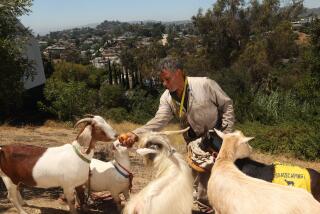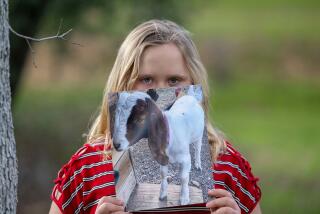Packing Up His Troubles
- Share via
As man has done for thousands of years, John Morgando looked to animals to lighten his load.
Traditional beasts of burden held no appeal for this Ojai naturalist, though. Horses would be overkill for carrying his 60 pounds of gear into the back country, he reasoned. Llamas are pricey and unpredictable.
Morgando turned instead to goats and found they are not the wimps they may appear to be. They’re capable, congenial and cheap, at about $175 each. Conditioning the goats is as simple as leading them to plants they like and letting them graze.
“I sit down and read a book and that’s basically their training,” Morgando said. “They’re bonded to me. Most of their training is keeping a positive relationship.”
Morgando got the idea from reading about America’s goat-packing pioneer, John Mionczynski. The biologist used goats while studying Rocky Mountain bighorn sheep for the U.S. Forest Service and in 1992 wrote the goat-packing bible, “The Pack Goat.” The book is a mixture of wit and technical advice featuring such chapters as “Why Pack a Goat? Or How to Get the Monkey Off Your Back” and “Goat Hairs in My Couscous (Life on the Trail).”
Mionczynski says his goats have carried up to 80 pounds each on long mountain trips, traveling as far as 15 miles a day. They are so quiet that they don’t disturb other animals. And sure-footed goats “can go where no other pack animal can go,” he wrote.
Most important, as Morgando knew from his 4-H days, goats are followers.
“They’re naturally gregarious,” Morgando said.
Mionczynski and Morgando are two voices in a small but growing choir singing the praises of pack goats. Rex Summerfield, owner of Northwest Pack Goats & Supplies in Idaho and a regular contributor to Goat Tracks: Journal of the Working Goat, said conservative estimates put the number of pack goat owners nationwide at 300, but that many other people rent them. A dozen 4-H groups now have pack goat projects.
*
More than 300 people subscribe to Goat Tracks, which addresses such issues as de-worming and gives readers a chance to swap stories. In the winter issue, Dale Smith from Red Bluff described how Keggar and Casey, the goats she and her husband bought to carry their beer on hikes, got violently ill on their first big trip after allegedly eating poisonous plants.
Business is relatively booming for the Summerfields.
“We have over 700 people on our mailing list and are adding over 100 per year,” Summerfield said. “The future looks bright for pack goats.”
*
Deer, not goats, are Morgando’s real passion. The son of a dairy herd manager, he grew up around animals in the then-open spaces of Port Hueneme and Tepusquet, near Santa Maria, and quickly became fascinated with deer. He likes to sit behind ridge-top bushes for hours, peering down into canyons through high-powered binoculars. He keeps track of deer coming and going up to three miles away.
With a single pair of binoculars weighing up to 15 pounds, packing for overnight treks became difficult even for a man with Morgando’s simple tastes. It often came down to choosing between a good pair of binoculars and a tent.
“When the bugs are bad, a tent is nice,” Morgando said frankly.
Three years ago, Morgando decided the time was right to buy his first goats. He had met his wife Wendy, a teacher, when she took her students to Santa Cruz Island where he lived and worked as a caretaker. They married and she took a job at Happy Valley School. He moved with her to a one-bedroom 1940s adobe on the Happy Valley Foundation’s 600-acre ranch in the shadow of the Topatopa Mountains and began working as a groundskeeper.
Morgando took one look at the wide open spaces around him and thought goats. Wendy took a little while to warm to the idea.
“I was confused,” Wendy recalled. ‘I grew up in New York and New Jersey. I never imagined I’d be living on a big plot of land, my husband would be so into animals and I’d drive a big truck with a trailer hitch. I didn’t know how it was going to work out, but it ended up being fun.”
Morgando said she couldn’t have been too surprised.
“When Wendy met me, she met a guy living on a deserted island, so she knew what she was getting into,” he said.
His goats, all brown castrated males uninterested in breeding and fighting, live in large pens five steps from the family’s back door.
Shorty is the head of the pack. Buster, the other 3-year-old, is a little skittish. Shemp, one of the yearlings, is a lot like Buster in that way. A long black goatee distinguishes the other yearling, Buffy.
*
There have been only a few minor mishaps since the goats came to live with the Morgandos. The goats ran into the house twice while Morgando tried to load them on the trailer. And during last year’s rainy season, they broke out of the pens and spent the night curled up together on a couch under the porch awning.
*
Morgando considers the goats family. He checks on them the second he gets home. When he visits his mother in Oregon, he puts them in a pen outside her house.
“I don’t leave town without them, basically,” Morgando said. “I just don’t like to leave them.”
Wendy has had to learn her place around the goats, and that place is behind Shorty. Shorty and Wendy’s husband lead the way on family walks through the meadows and hills surrounding their home. Wendy, the couple’s 3-year-old daughter, Sophie, and the rest of the goats follow.
“Shorty doesn’t like me,” Wendy said. “He’s jealous, I think. He doesn’t like it if I try to walk up by John. He horns me.”
“He’s not horning you,” Morgando said in Shorty’s defense. “He’s showing his horns. He’s posturing.”
Nonetheless, Wendy said, “I don’t go too often.”
Morgando started taking long walks with the goats when they were babies to condition them. Once the older two were a year old, he could put packs on them. For about a week before big trips, he has them walk with full loads for two hours a day.
Morgando has found time for only three long treks. The first was a two-day hike over 22 miles in the Sespe Wilderness last year. He and a goat-packing friend piled 30 pounds of gear onto each of three goats and everything went smoothly. Rain and a lack of deer hampered two three-day trips in the Santa Lucia Wilderness near San Luis Obispo that followed, but the goats were troopers.
*
On short and long hikes, Morgando tries to keep a low profile, a difficult task with a line of goats in tow. People who spot him near roads often make a couple of U-turns to take a closer look, and hikers can’t help but make comments like, “Is the one in front Rudolph?”
“It’s very funny seeing the goats with packs,” Wendy said. “He always gets embarrassed about it.”
“As long as I had a good trip,” Morgando insisted, “It’s all fine.”
More to Read
Sign up for The Wild
We’ll help you find the best places to hike, bike and run, as well as the perfect silent spots for meditation and yoga.
You may occasionally receive promotional content from the Los Angeles Times.






